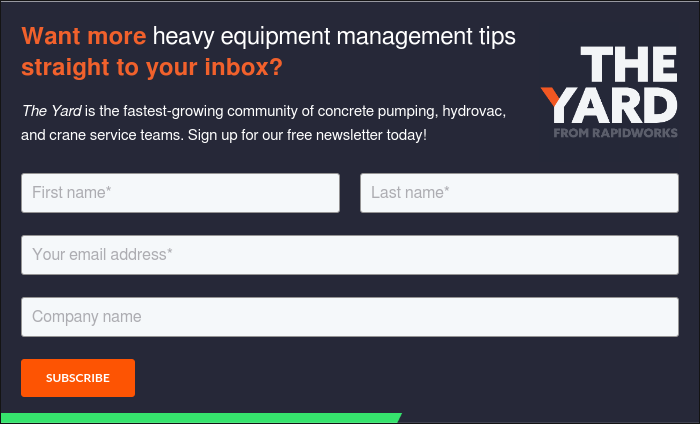
5 WorkForce Development Strategies to Strengthen your Crane Business
Business success starts with sound hiring practices that bring aboard the best people. However, skilled workers don't guarantee profit or growth.
For businesses to grow, their workforces must grow as well, but not necessarily in size. Rather, employees require training, skill development, and a culture of trust and mentorship.
Crane businesses often have high turnover rates, given the industry's inherent risks and hazards, such as overloading and power-line contact. With all the necessary training, technical knowledge, and safety concerns, it's critical to understand how to grow your crane business through workforce development. In this article, we'll explore strategies to grow your workforce sustainably.
We'll cover:
- Cost Effective Workforce Development Strategies
- Long-Term Investments in Workforce Sustainability
Cost-Effective Workforce Development Strategies
The idea behind workforce development is simple: Strategic planning improves your employees' abilities, morale, and performance. However, workforce improvement is no cakewalk. It takes some work and a multi-pronged approach that merges direct action with long-term thinking.
Cross-Train All Operators and Riggers
Cross-training is foundational to improving workforce development. Crane operations are dynamic, requiring different roles to guarantee safety and efficiency.
The American Society of Mechanical Engineers (ASME) and Occupational Safety and Health Administration (OSHA) have outlined the various personnel required for safe crane operations:
- Crane owners
- Crane operators
- Site supervisors
- Lift directors
There are also rigging crews, which vary in size depending on the project's nature, such as if it's a mobile or static crane.
Companies must look to cross-train their employees whenever possible. Doing so comes with many benefits, including:
- Increases flexibility and efficiency
- Reduces the need for hiring additional workers
- Boosts job satisfaction
- Saves on labor costs
- Reduces delays or downtime
Cross-training can also help battle the construction industry's crippling skilled-labor shortage.
Pro tip: Start designing a cross-training program by defining your goals, compiling resources, identifying specific cross-training tasks, and communicating the benefits to those in the program.
Utilize Technology to Enhance Your Training and Safety
Digitizing your training and safety programs can help your team stay abreast of the constantly evolving crane safety standards.
Technology is key for developing a structured approach to workforce development, and it makes cross-training much easier. Using digital platforms, crane teams can keep their crew informed on safety standards and procedures by conducting VR crane simulations, distributing safety packets, and offering e-learning courses.
These solutions provide realistic training experiences without putting equipment or personnel at risk. With these tools at their disposal, employees can practice advanced maneuvers and problem-solving scenarios without racking up the expenses involved with live training.
Pro tip: Digital tools like Visual Dispatch by RapidWorks can streamline compliance tracking for employee certifications via Cards, ensuring operators and riggers stay up to date on the necessary requirements.
Implement an Employee Referral Program
Want to reduce your hiring costs, improve your retention rate, and increase your employee engagement? Trust your current employees to recommend the right candidates for your job openings.
Referral programs incentivize employees to refer the best operators and riggers they know. Not only does this reduce the average time to hire and the associated costs, but it also promotes stronger workforce development over time, because referred employees tend to be better cultural fits.
Long-Term Investments in Workforce Sustainability
Workforce development takes a stronger effort than some one-off training seminars. Forming a tight-knit team with organizational commitment takes long-term strategic thinking.
Develop Leadership and Mentorship Programs
Make sure your star players rise to the top. Establishing leadership training for high-potential operators and riggers prepares them to step into supervisory or management roles as soon as the time is right. Form a structured pipeline to invest in future leaders without wasting time.
Try pairing experienced operators and riggers with new hires right from the start. This practice creates a mentorship culture that supports knowledge sharing and professional skill development. As a result, you reduce costly turnover, decrease safety risks, and foster stronger professional relationships.
Encourage Employee Feedback and Involvement
Businesses often fall short when they fail to consider the struggles and needs of their employees. Conduct regular employee surveys, hold meaningful feedback sessions, and build channels for your employees to express their needs, concerns, and suggestions for improving the work environment.
Listening to, and acting on, employees' feedback shows them that their opinions have value. Always involve your operators and riggers in decisions related to job site safety, operational improvements, and equipment investments.
Pro tip: Giving them a voice in the company's decisions empowers your employees, making them feel more invested in the company's success.
